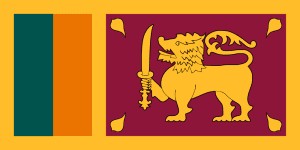
| Colors | HEX Code | RGB | CMYK |
|---|---|---|---|
| Yellow | #FFBE29 | 255, 190, 41 | 0, 25, 84, 0 |
| Green | #00534E | 0, 83, 78 | 100, 0, 6, 67 |
| Orange | #EB7400 | 235, 116, 0 | 0, 51, 100, 8 |
| Red | #8D153A | 141, 21, 58 | 0, 85, 59, 45 |
The flag of Sri Lanka has a yellow border on the four sides. On the hoist side, there are two vertical stripes colored green to the left and orange to the right. On the fly side, there is a crimson rectangle, with a sword-wielding lion and four Bo leaves.
Meaning of the Sri Lankan Flag
The lion in the flag represents the Sinhala race. The sword of the lion represents the sovereignty of the country. The vertical stripe of orange stands for the minority Tamil race and the green vertical stripe is for the minority Muslim race. The maroon-colored portion of the flag manifests the other minor religions, and so does the yellow border around the flag which represents other minorities. The bo leaves at the four corners of the flag represent Buddhism and its influence on the country. They also stand for the four virtues – Kindness, Friendliness, Happiness, and Equanimity.
History of the Sri Lankan Flag
Sri Lanka was ruled by various dynasties. Each of the dynasties had its own flag. Sri Lanka, then known as Ceylon, was colonized by European countries as early as the 16th century. The Portuguese arrived first and ruled the country from 1505 to 1658. Then the Dutch took control (1658–1796), and finally the British (1796–1948). The colonial flags were raised in Ceylon through different colonial periods. In 1875, the British introduced a new flag for Ceylon, featuring a Union Jack in the canton and a blue ensign with a green emblem of a golden lion holding a sword on the flyside. This flag represented Ceylon until independence. Upon gaining independence from Britain in 1948, Ceylon initially used a flag with the Union Jack in the canton and a green field with a golden lion holding a sword. In 1951, the design was modified by replacing the lion with a stylized Buddha sitting on a lotus. Sri Lanka became a republic in 1972, and the country adopted the new flag that is still used today. It represents different ethnicities and values of the Sri Lankan people.